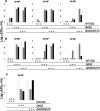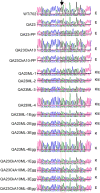Evidence of expanded host range and mammalian-associated genetic changes in a duck H9N2 influenza virus following adaptation in quail and chickens
- PMID: 18779858
- PMCID: PMC2525835
- DOI: 10.1371/journal.pone.0003170
Evidence of expanded host range and mammalian-associated genetic changes in a duck H9N2 influenza virus following adaptation in quail and chickens
Abstract
H9N2 avian influenza viruses continue to circulate worldwide; in Asia, H9N2 viruses have caused disease outbreaks and established lineages in land-based poultry. Some H9N2 strains are considered potentially pandemic because they have infected humans causing mild respiratory disease. In addition, some of these H9N2 strains replicate efficiently in mice without prior adaptation suggesting that H9N2 strains are expanding their host range. In order to understand the molecular basis of the interspecies transmission of H9N2 viruses, we adapted in the laboratory a wildtype duck H9N2 virus, influenza A/duck/Hong Kong/702/79 (WT702) virus, in quail and chickens through serial lung passages. We carried out comparative analysis of the replication and transmission in quail and chickens of WT702 and the viruses obtained after 23 serial passages in quail (QA23) followed by 10 serial passages in chickens (QA23CkA10). Although the WT702 virus can replicate and transmit in quail, it replicates poorly and does not transmit in chickens. In contrast, the QA23CkA10 virus was very efficient at replicating and transmitting in quail and chickens. Nucleotide sequence analysis of the QA23 and QA23CkA10 viruses compared to the WT702 virus indicated several nucleotide substitutions resulting in amino acid changes within the surface and internal proteins. In addition, a 21-amino acid deletion was found in the stalk of the NA protein of the QA23 virus and was maintained without further modification in the QA23CkA10 adapted virus. More importantly, both the QA23 and the QA23CkA10 viruses, unlike the WT702 virus, were able to readily infect mice, produce a large-plaque phenotype, showed faster replication kinetics in tissue culture, and resulted in the quick selection of the K627 amino acid mammalian-associated signature in PB2. These results are in agreement with the notion that adaptation of H9 viruses to land-based birds can lead to strains with expanded host range.
Conflict of interest statement
Figures




Similar articles
-
H9N2 Influenza Virus Infections in Human Cells Require a Balance between Neuraminidase Sialidase Activity and Hemagglutinin Receptor Affinity.J Virol. 2020 Aug 31;94(18):e01210-20. doi: 10.1128/JVI.01210-20. Print 2020 Aug 31. J Virol. 2020. PMID: 32641475 Free PMC article.
-
Molecular basis of efficient replication and pathogenicity of H9N2 avian influenza viruses in mice.PLoS One. 2012;7(6):e40118. doi: 10.1371/journal.pone.0040118. Epub 2012 Jun 29. PLoS One. 2012. PMID: 22768236 Free PMC article.
-
Replication and transmission of mammalian-adapted H9 subtype influenza virus in pigs and quail.J Gen Virol. 2015 Sep;96(9):2511-2521. doi: 10.1099/vir.0.000190. Epub 2015 May 18. J Gen Virol. 2015. PMID: 25986634 Free PMC article.
-
H9N2 influenza viruses possessing H5N1-like internal genomes continue to circulate in poultry in southeastern China.J Virol. 2000 Oct;74(20):9372-80. doi: 10.1128/jvi.74.20.9372-9380.2000. J Virol. 2000. PMID: 11000205 Free PMC article.
-
Characterization of the pathogenicity of members of the newly established H9N2 influenza virus lineages in Asia.Virology. 2000 Feb 15;267(2):279-88. doi: 10.1006/viro.1999.0115. Virology. 2000. PMID: 10662623
Cited by
-
Genetic Adaptation of Influenza A Viruses in Domestic Animals and Their Potential Role in Interspecies Transmission: A Literature Review.Ecohealth. 2016 Mar;13(1):171-98. doi: 10.1007/s10393-014-1004-1. Epub 2015 Jan 29. Ecohealth. 2016. PMID: 25630935 Review.
-
H9N2 Influenza Virus Infections in Human Cells Require a Balance between Neuraminidase Sialidase Activity and Hemagglutinin Receptor Affinity.J Virol. 2020 Aug 31;94(18):e01210-20. doi: 10.1128/JVI.01210-20. Print 2020 Aug 31. J Virol. 2020. PMID: 32641475 Free PMC article.
-
Molecular basis of efficient replication and pathogenicity of H9N2 avian influenza viruses in mice.PLoS One. 2012;7(6):e40118. doi: 10.1371/journal.pone.0040118. Epub 2012 Jun 29. PLoS One. 2012. PMID: 22768236 Free PMC article.
-
Airborne Transmission of Avian Origin H9N2 Influenza A Viruses in Mammals.Viruses. 2021 Sep 24;13(10):1919. doi: 10.3390/v13101919. Viruses. 2021. PMID: 34696349 Free PMC article. Review.
-
Emergence and genetic variation of neuraminidase stalk deletions in avian influenza viruses.PLoS One. 2011 Feb 23;6(2):e14722. doi: 10.1371/journal.pone.0014722. PLoS One. 2011. PMID: 21373190 Free PMC article.
References
-
- Homme PJ, Easterday BC. Avian influenza virus infections. I. Characteristics of influenza A-turkey-Wisconsin-1966 virus. Avian Dis. 1970;14:66–74. - PubMed
-
- Alexander DJ. An overview of the epidemiology of avian influenza. Vaccine. 2007;25:5637–5644. - PubMed
-
- Guo Y, Li J, Cheng X. [Discovery of men infected by avian influenza A (H9N2) virus]. Zhonghua Shi Yan He Lin Chuang Bing Du Xue Za Zhi. 1999;13:105–108. - PubMed
-
- Kim JA, Cho SH, Kim HS, Seo SH. H9N2 influenza viruses isolated from poultry in Korean live bird markets continuously evolve and cause the severe clinical signs in layers. Vet Microbiol. 2006;118:169–176. - PubMed
Publication types
MeSH terms
Grants and funding
LinkOut - more resources
Full Text Sources
Medical

